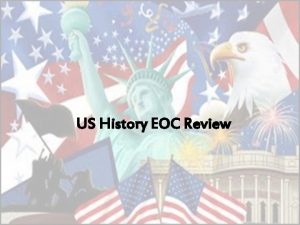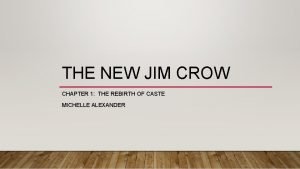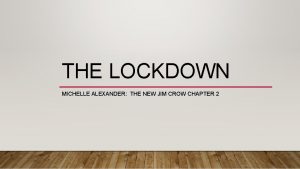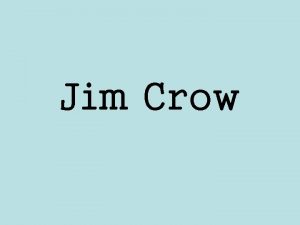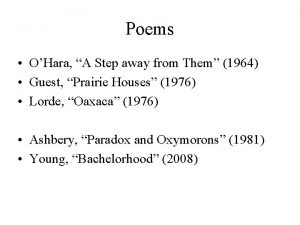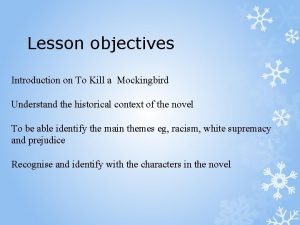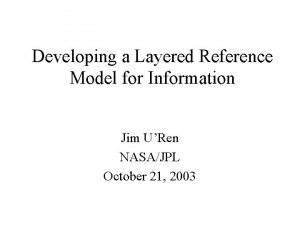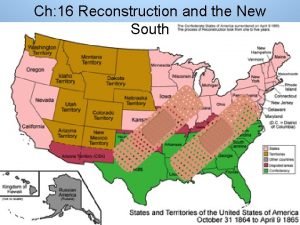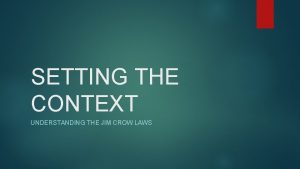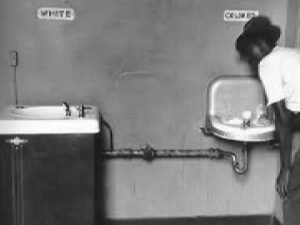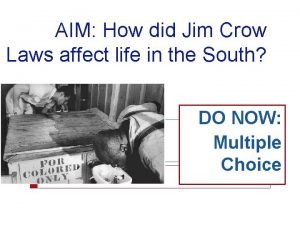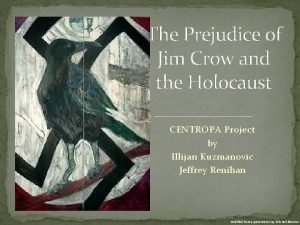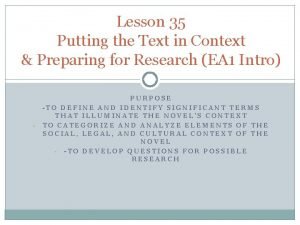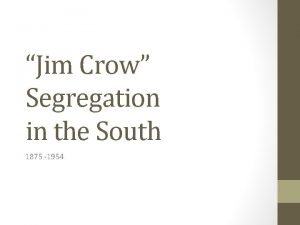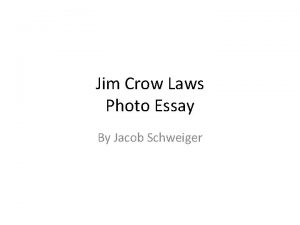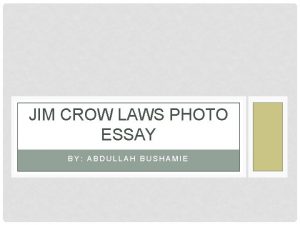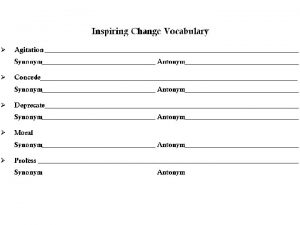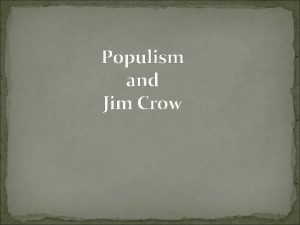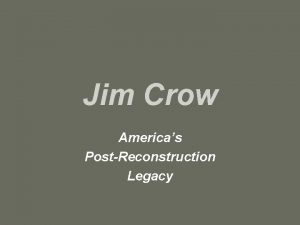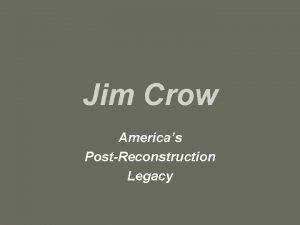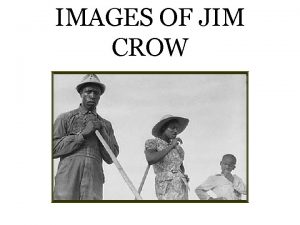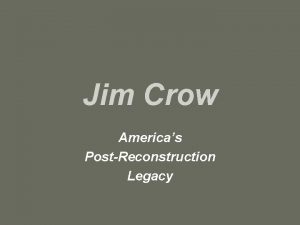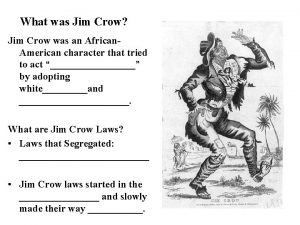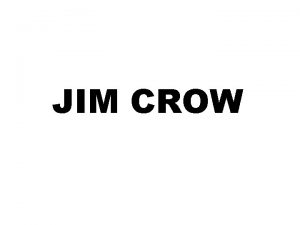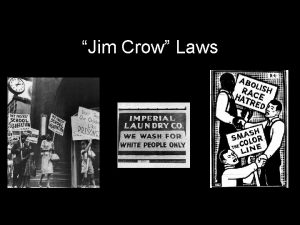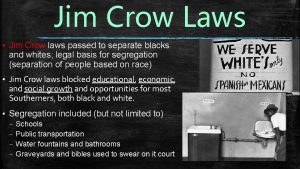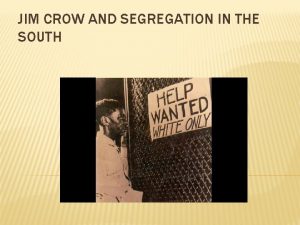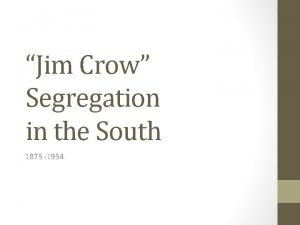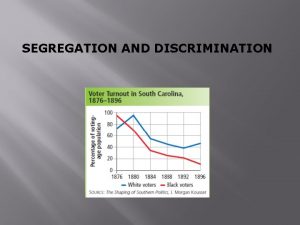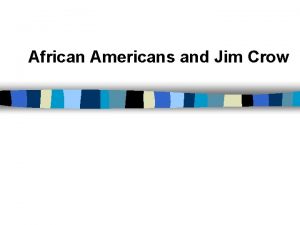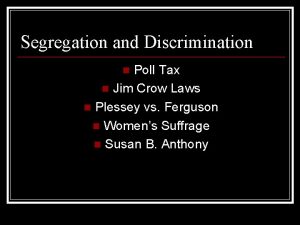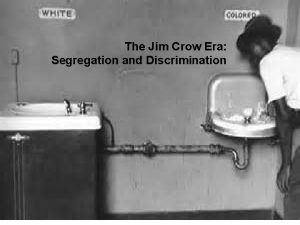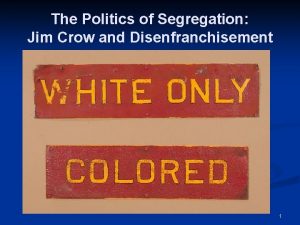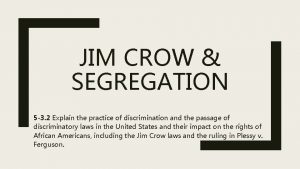JIM CROW AND SEGREGATION IN THE SOUTH As
























- Slides: 24

JIM CROW AND SEGREGATION IN THE SOUTH

As Reconstruction ended, African American dreams o equality and justice faded. • By the 1880 s, racism and segregation took a strong h Southern states (Northern states also harbored discrimination, but no pronounced as in the South)

Voting Restrictions Southern States passed laws to get around the 15 th Amendment (15 th Amendment: states could not deny an individua the right to vote because of race, color, or previous servitude)

Poll Tax: a fee that people had to pay before they could vote. Many African Americans could not pay the fee, thus they could not vote. (this also kept poor whites from voting)

Literacy Tests: people who wanted to vote had to read difficult parts of the State or U. S. Constitution explain it Many African Americans had little education and could not read the Constitutions, thus they could not vote

Grandfather Clause: laws which allowed individuals who did not pass the literacy test to vote if their father or grandfather had voted before Reconstruction African Americans could not vote until 1867 (after Reconstruction), so these laws excluded African Americans

Poll tax, literacy tests, and grandfather clauses were enacted as early as 1870, but became widespread after 1889. By 1890, segregation was a prominent feature of life in the South

Jim Crow Laws and the South

The term Jim Crow originated in a song performed by Daddy Rice, a white minstrel show entertainer in the 1830 s. Rice covered his face with charcoal paste or burnt cork to resemble a black man, and then sang and danced a routine in caricature of a silly black person. By the 1850 s, this Jim Crow character, one of several stereotypical images of black inferiority in the nation's popular culture, was a standard act in the minstrel shows of the day. How it became a term synonymous with the brutal segregation and disfranchisement of African Americans in the late nineteenth-century is unclear. What is clear, however, is that by 1900, the term was generally identified with those racist laws and actions that deprived African Americans of their civil rights by defining blacks as inferior to whites, as members of a caste of subordinate people. Historyof. Jim. Crow. org

Discrimination against African-Americans continued in the South after reconstruction Racial Segregation • Based on race • Directed primarily against African-Americans, but other groups were also kept segregated • American Indians were not considered citizens until 1924

“Jim Crow” Laws: • “Jim Crow” laws institutionalized a system of legal segregation • Passed to discriminate against African-Americans • Made discrimination practices legal in many communities and states • Were characterized by unequal opportunities in housing, work, education, and government

“It shall be unlawful for a negro and white person to play together or in company with each other in any game of cards or dice, dominoes or checkers. ” —Birmingham, Alabama, 1930

“Marriages are void when one party is a white person and the other is possessed of one-eighth or more negro, Japanese, or Chinese blood. ” —Nebraska, 1911

“Separate free schools shall be established for the education of children of African descent; and it shall be unlawful for any colored child to attend any white school, or any white child to attend a colored school. ” —Missouri, 1929

“All railroads carrying passengers in the state (other than street railroads) shall provide equal but separate accommodations for the white and colored races, by providing two or more passenger cars for each passenger train, or by dividing the cars by a partition, so as to secure separate accommodations. ” —Tennessee, 1891

“The Corporate Commission is hereby vested with power to require telephone companies in the State of Oklahoma to maintain separate booths for white and colored patrons when there is a demand for such separate booths. ” —Oklahoma, 1915

Challenge to Jim Crow Laws

Plessy vs. Ferguson • In 1892, Homer Plessy, who was 7/8 white, purposely challenged the segregation laws by sitting in a white’s only train car in Louisiana • When he announced that he was considered African-American because he was 1/8 African-American, the train officials tried to move him to a “colored only” train car. • Upon his refusal, he was arrested. Ferguson was the judge in the Louisiana case who said Plessy was guilty of violating the “Separate Car Law”

Why does this matter ? ? ? ? ? ? ? ? ?

This led to a landmark Supreme Court decision: Plessy vs. Ferguson (1896) • Supreme Court of the United States stated that facilities and services could be separate as long as they were equal. • “Separate, but equal” clause legally allowed segregation (not overturned until 1950 s)

BOOKER T. WASHINGTON African. American civic leader who believed equality could be achieved through vocational education. •

Booker T. Washington was born a slave • He knew the South’s attitude towards former slave • He believed that African Americans could gain equ rights by being economically independent. (through vocational education) o In other words, African Americans should mak living for themselves by learning a trade such a carpentry, masonry, sewing, etc. so they could homes, food, and provide for their families • He accepted segregation as African Americans worke their way toward equality • He was called the Great Accommodator (accepting w attitudes)

W. E. B. DUBOIS African-American civic leader who believed in immediate full political, civil, and social rights for African. Americans.

W. E. B. Dubois was born in Massachusetts after the civ (he was never a slave) • W. E. B was well educated. He went to school with white children • He was disgusted by segregation and wanted full political, civil, and social rights for African Americ (without waiting for it) • He opposed Booker T. Washington’s philosophy o accommodation
 Main idea
Main idea Advantages of directive counselling
Advantages of directive counselling The new jim crow chapter 1
The new jim crow chapter 1 The new jim crow chapter 2
The new jim crow chapter 2 Jim crow character
Jim crow character A step away from them frank o'hara
A step away from them frank o'hara Fur trapping apothecary
Fur trapping apothecary Jim crow laws defintion
Jim crow laws defintion Apartheid vs jim crow venn diagram
Apartheid vs jim crow venn diagram Jim crow laws in what region or regions did it exist
Jim crow laws in what region or regions did it exist Understanding jim crow (setting the setting)
Understanding jim crow (setting the setting) Jim crow (character)
Jim crow (character) Jim crow laws definition
Jim crow laws definition Jim crow laws
Jim crow laws Jim crow laws
Jim crow laws Jim crow states
Jim crow states Jim crow shorthand for separation
Jim crow shorthand for separation Segregation images
Segregation images Conclusion martin luther king
Conclusion martin luther king Jim crow photo essay
Jim crow photo essay Jim crow pictures
Jim crow pictures Jim crow
Jim crow Old south vs new south streetcar named desire
Old south vs new south streetcar named desire Theme of the crow and the pitcher
Theme of the crow and the pitcher Jeff frisby
Jeff frisby
